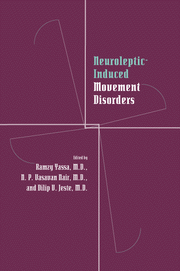Book contents
- Frontmatter
- Contents
- Contributors
- Preface
- Part I Historical perspective
- Part II Clinical aspects of tardive dyskinesia
- 2 Aging and tardive dyskinesia
- 3 Gender as a factor in the development of tardive dyskinesia
- 4 The Yale tardive dyskinesia study: a prospective incidence study among long-term outpatients
- 5 Vulnerability to tardive dyskinesia in schizophrenia: an exploration of individual patient factors
- 6 Tardive dyskinesia and affective disorder
- 7 Diabetes mellitus and tardive dyskinesia
- 8 Other factors in the development of tardive dyskinesia
- 9 Neuroleptic treatment and tardive dyskinesia
- 10 Anticholinergic drugs as factors in the development of tardive dyskinesia
- Part III Mechanisms underlying tardive dyskinesia
- Part IV Measurement of tardive dyskinesia
- Part V Tardive dyskinesia in different populations
- Part VI Other neuroleptic-induced movement disorders
- Part VII Treatment of tardive dyskinesia
- Index
8 - Other factors in the development of tardive dyskinesia
from Part II - Clinical aspects of tardive dyskinesia
Published online by Cambridge University Press: 09 October 2009
- Frontmatter
- Contents
- Contributors
- Preface
- Part I Historical perspective
- Part II Clinical aspects of tardive dyskinesia
- 2 Aging and tardive dyskinesia
- 3 Gender as a factor in the development of tardive dyskinesia
- 4 The Yale tardive dyskinesia study: a prospective incidence study among long-term outpatients
- 5 Vulnerability to tardive dyskinesia in schizophrenia: an exploration of individual patient factors
- 6 Tardive dyskinesia and affective disorder
- 7 Diabetes mellitus and tardive dyskinesia
- 8 Other factors in the development of tardive dyskinesia
- 9 Neuroleptic treatment and tardive dyskinesia
- 10 Anticholinergic drugs as factors in the development of tardive dyskinesia
- Part III Mechanisms underlying tardive dyskinesia
- Part IV Measurement of tardive dyskinesia
- Part V Tardive dyskinesia in different populations
- Part VI Other neuroleptic-induced movement disorders
- Part VII Treatment of tardive dyskinesia
- Index
Summary
Although tardive dyskinesia is defined as a movement disorder that develops after 3 months of drug treatment (Jeste & Wyatt, 1982), the fact that some patients develop this side effect earlier means that they may have a greater predisposition to the condition. Various authors have speculated as to the different mechanisms for this vulnerability; in this chapter we shall look at genetic factors and smoking.
Genetic Factors
Recently, hereditary susceptibility to tardive dyskinesia has been the subject of much discussion. Brandon, McClelland, and Protheroe (1971), for example, have suggested that blue-eyed men are more prone to develop tardive dyskinesia than brown-eyed men, although Gardos, Sokol, and Coel (1976) could not confirm that finding, nor could it be confirmed in women. In a study of six pairs of twin patients (four monozygotic and two dizygotic) treated with high-dosage neuroleptics, Jacob Brody found that the specific type of neurological side effect was not determined genetically, inasmuch as the identical twins showed distinctly different reaction patterns (Jeste & Wyatt, 1982). Moreover, Jeste, Phelps, and Wyatt (1982), in a study of 50-year-old female schizophrenic quadruplets on neuroleptic treatment, found that only one of the four had definite tardive dyskinesia. Weinhold, Wegner, and Kane (1981), however, reported the presence of tardive dyskinesia in two schizophrenic brothers treated with neuroleptics. Yassa and Ananth (1981) found that of eight pairs of family members, two were concordant for tardive dyskinesia, and six for the absence of tardive dyskinesia.
- Type
- Chapter
- Information
- Neuroleptic-induced Movement DisordersA Comprehensive Survey, pp. 99 - 103Publisher: Cambridge University PressPrint publication year: 1996



